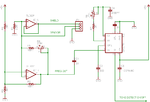maxima_diesel
Junior Member level 1
Hi, Im a student and we have a project where we are designing a touchless air piano (similar effect to this: A New Instrument - how it works - YouTube). I am in charge in designing the sensors. Basically the sensors would have to detect the distance of the hand from the sensor. The output should be analog in between 0 to 5V, this output is connected to an ADC to be interpreted. The distance of the hand to the sensor is needed for velocity calculation. So basically the close the hand gets to the sensor the louder the air piano's key would get. I have done some research prior to this post but a little assistance would help a lot from you guys. I have tested modulated sensors with different carrier frequencies and I used 555 timer to set the output of the emitter to the correct frequency. The only problem is that, modulated sensors like that I have used like this : http://www.rentron.com/Files/pna4601m.pdf An issue with this sensor is that the output that it generates is digital-ish, meaning when it senses an object (hand) it turns to 4.8v and when its not sensing anything its at 700mv. It isn't analog at all, It's liek there's a threshold, the only advantage of this is that its already modulated and the range is approximately 30 cm. However, I have found a sensor similar to this but the output voltage doesnt vary with distance rather with the pulse width, and when I looked at the output from the oscilloscope it seems that it still had a threshold voltage when the hand is detected, not good enough. My aim is basically create an IR sensor and receiver with an output similar to this well-known ready made sensor that everyone uses: http://www.farnell.com/datasheets/653395.pdf or SHARP|GP2Y0A02YK0F|SENSOR, DISTANCE, ANALOGUE O/P | Farnell United Kingdom. The pre-made sensors have a real analogue output which is what we needed because velocity calculation would be possible and it is our aim for our project. Then I tried creating another ir emitter sensor circuit with ANALOG voltage output. I strated by basically creating the circuit stated in this tutorial: **broken link removed**. Instead of using a 3-pin modulated sensor I just used a basic IR LED receiver (2 pins) and IR LED emitter, just like it says in the tutorial. The output voltage of this setup is analog indeed but, the range it has is only 4.7V to 5.0V. The range is 300mV, which is not enough. I need an analog output voltage from 0 to 5 V. So I decided to connect the output of the IR sensor to a BJT like in this setup: **broken link removed**. I've to modify that circuit because the IR emitter is not connected to a microcontroller in my design, and the analog output is not connected to a microcontroller either. With this setup output is definitely analog but the range is 3V to 5V, but I need an analog output to be 0 to 5V or even 0 to 3V. I am thinking of connecting the output of this setup to an op amp to convert the range to 0 to 5v, but I am not sure how to, is it ok if any of you guys can assist me on doing this? The range of this setup is 25-30cm which is good enough. Also I would like to know how to modulate the IR LED sensor so that it will become more immune to ambient lighting, I think I could use a bandpass filter maybe?? Basically again my aim is to have analog output voltage from 0 to 5V, immune to ambient lighting, range should reach approximately 30cm. I would greatly appreciate any of your assistance. Thank you very much in advance.
